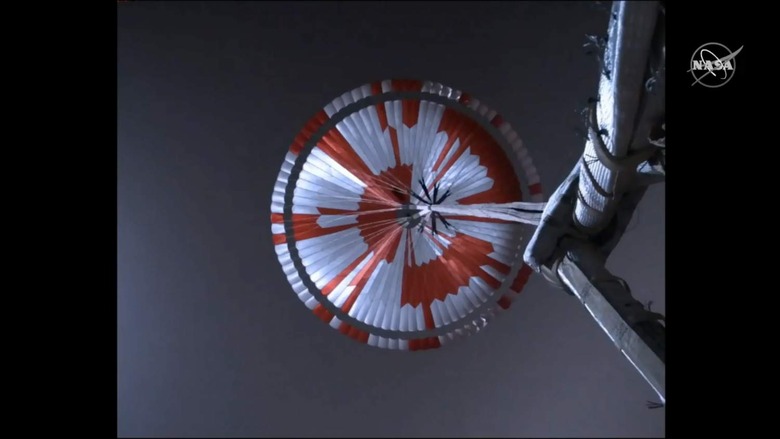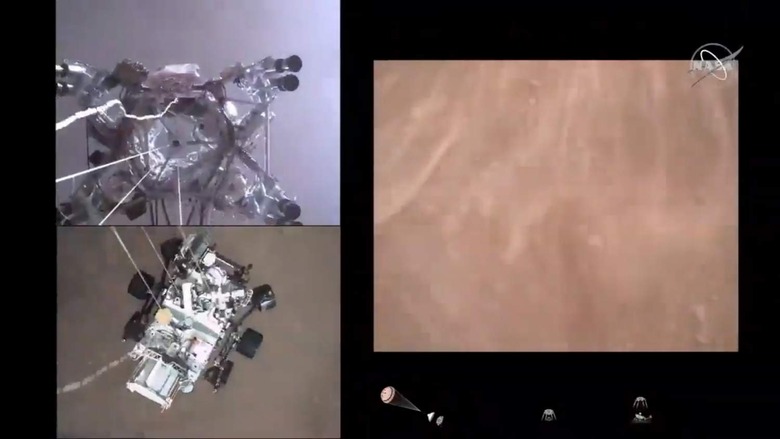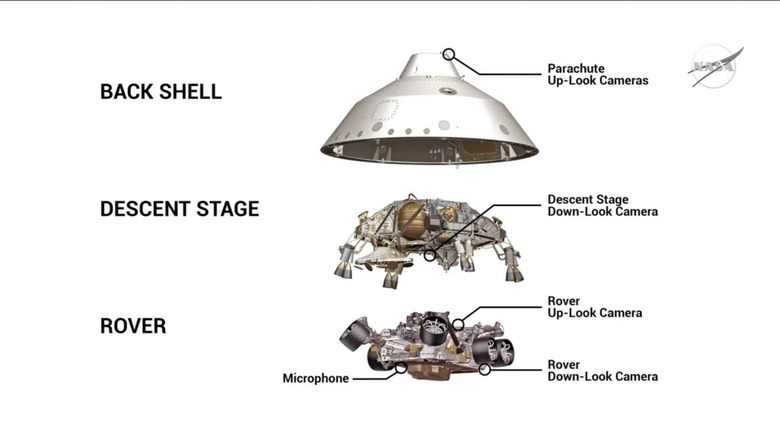Watch The NASA Perseverance Mars Rover Landing In This Incredible Video
NASA has revealed video of the Perseverance rover's audacious landing on Mars, with "How to Land on Mars" including never-before-seen footage of the dramatic touchdown late last week. It was the culmination of multiple years of planning and seven months of travel from Earth to the red planet, and plenty could've gone wrong.
The landing was never just going to be a matter of turning the spacecraft around and depositing Perseverance on Martian soil. First came extreme deceleration, the spacecraft using Mars' atmosphere to shed huge amounts of speed. A vast parachute slowed Perseverance further, to the point where the casing could be released.

A total of sixteen rockets then brought the so-called jetpack down to just above the surface, before the rover was lowered on four cables underneath – using a system NASA calls the Sky Crane – the last 70 feet or so. That way, it could accommodate any unruly terrain as its six individually powered and articulated wheels made contact.
Lending more stress was the fact that NASA couldn't remotely fly the landing process. Indeed, it was pretty much set from the beginning, since the time delay for sending a signal from Earth to Mars is actually longer than the landing process itself took. At around 22 minutes for a round-trip message, that was simply too much latency to deal with any unforeseen issues.

As a result, Perseverance was its own pilot. That included last-minute scanning of the ground underneath the jetpack to ensure the terrain was suitable, and any final adjustments. By the time NASA's Jet Propulsion Lab – which runs the rover project – got word of a successful landing, Perseverance had actually been chilling out on the surface of Mars for several minutes.
The footage was filmed by the Entry Descent and Landing system, which was added to the flight vehicle just to give a glimpse of the experience of landing on Mars. According to Dave Gruel, Perseverance Entry, Descent, and Landing camera suite lead, the system couldn't interfere in any way with the spacecraft and the rover. "In the end, we knew ... the mission could still be 100-percent successful even if our camera system didn't work."

A little over 30GB information – including over 23,000 images – was gathered during the landing process. There were multiple cameras, some looking up at the parachute and mounted on the back shell, a Descent Stage down-look camera, one on the top of the rover to look up at the descent stage, and then finally a down-facing camera under the rover. A microphone was also mounted there, but according to Gruel it didn't actually capture any audio.
Persereveance won't, of course, be spending much time idle from now on. As well as bringing the various systems – including seven different instruments, and almost 20 cameras – online, running them through diagnostics, and generally giving them the green light for the geological and other surveys the JPL and its partners have in mind, Perseverance also needs to deploy its stowaway. That's the Mars helicopter, Ingenuity.
Ingenuity's role will be to demonstrate that powered flight is possible on another planet. It's a proof of concept more than anything, with the helicopter expected to charge up and then take to the Martian skies to snap photos and film video. Future missions, however, will use Ingenuity's findings for more scientific endeavors, as well as potentially to support crewed trips to Mars with an ad-hoc communications network.
That won't be for some time yet, though NASA is planning a trip to visit Perseverance before then. One of the rover's goals on Mars is to collect samples and package them up into specially-designed tubes, created to last multiple years on the surface of the planet. A future mission, in cooperation with the European Space Agency (ESA) will gather those cached samples and bring them into orbit around the planet, with a subsequent mission after that retrieving them and bringing them back to Earth for deeper analysis.
